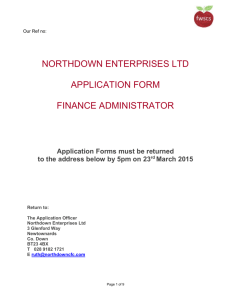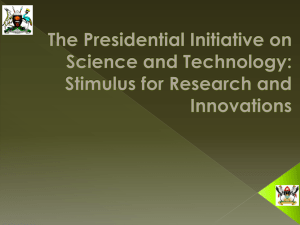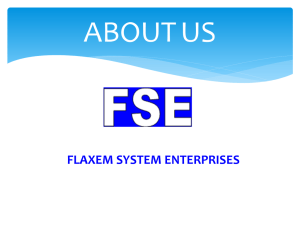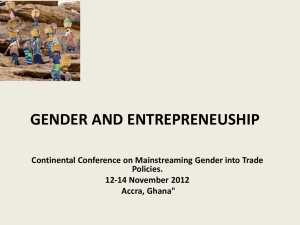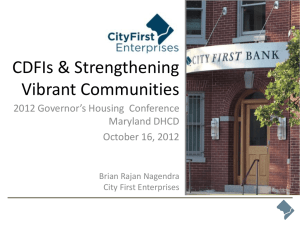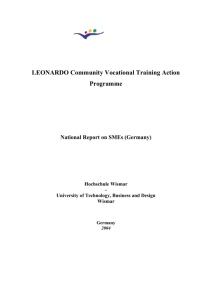Makerere-Presidential-Initiative-Forum-Presentation-FTBIC
advertisement
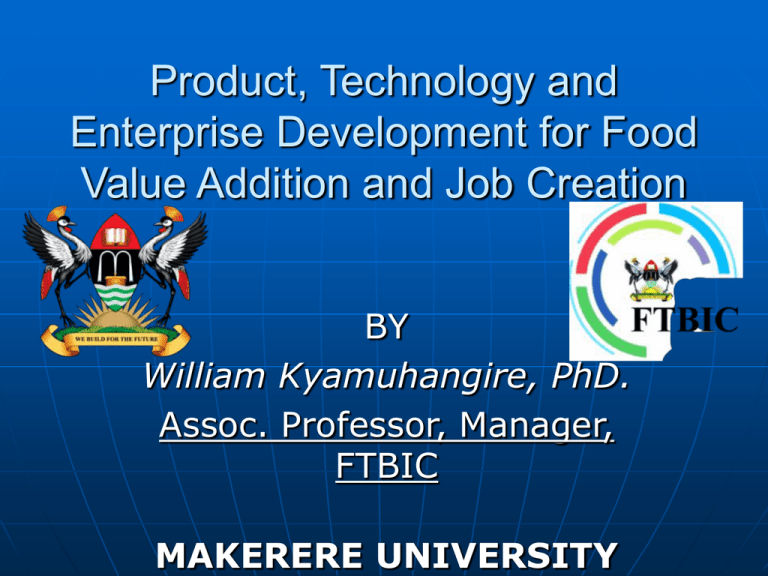
Product, Technology and Enterprise Development for Food Value Addition and Job Creation BY William Kyamuhangire, PhD. Assoc. Professor, Manager, FTBIC MAKERERE UNIVERSITY Introduction Uganda’s (Africa’s) Development Challenge "When we sell a kilo of bean coffee in Uganda, we get one dollar per kilo, ... The same kilo, when it is processed [and sold in Britain], goes for $10, $11 or even more a kilo. That is the same situation [price disparity] that goes for all raw materials.“ Museveni, “There are two problems that we, as a country, must solve. We must create opportunities for people to earn a living. Fast. The other is to find something of value that we, as Ugandans, take to the market and sell sustainably over a long term for a high return. “ Kabushenga, 2013. Uganda’s development challenges (Vision 2040) Low Competitiveness; Weak public sector management and administration; • Lack of public institutional support Ideological disorientation; Low industrialisation and value addition • GDP is still largely dominated by primary products. • As a result: unfavourable balance of payments, poor skills transfer, low levels of employment and high poverty levels. • Low levels of Science, Technology, Engineering and Innovation (STEI). Limited government investment in strategic and emerging industries Low level of saving and inadequate revenue collection; What we need to do Africa's ability to sustain its current growth will depend largely on how quickly it will be able to shift from reliance on traditional commodity markets to modern economic structures that focus on technologydriven development. "On the Wings of Innovation: Africa 2024,“ “The real solution is investment in infrastructure, commercialising agriculture and expanding our industrial base.” Museveni, As a latecomer Africa has the benefit of tapping into vast quantities of technological knowledge available worldwide. The continent's leapfrogging into the mobile revolution illustrated the power of latecomer advantages. Africa is now the origin of new industries such as mobile money transfer. Juma, 2012 Universities are recognized as sources of knowledge creation, innovation and technological advances. Across the globe, they are being positioned as strategic assets in innovation and economic competitiveness, and as problem-solvers for socio-economic issues affecting their countries. Sebuwufu, 2012 Macroeconomic Strategies (Vision 2040) Realise appropriate growth in investment spending as a proportion of national income, increase in growth of private capital and labour utilization and productivity. Incentives will be provided to increase the size of the productive labour by fostering labour mobility, increase research and development activities and the utilization of research and innovation products. To build a stronger and more competitive industrial base • i) developing industries that utilise the local potential, • • • • ii) attracting industries that can be relocated from fast emerging economies, iii) offshoring industries, iv) establishing economic lifeline industries, and v) investing in strategic industries. Emphasis will be put in the establishment of economic lifeline industries including; agro-based industries, iron and steel industry, oil and gas industry and building a strong STEI foundation that will be a spring-board for advanced industrialisation. Makerere University Strategic Plan 2007/08-2017/18 Strategic pillars of the University 1. 2. 3. Teaching and Learning Research and Innovations Outreach Research and Innovation Goals 1. To enhance knowledge generation and access in both science and humanities disciplines with a view to repositioning Makerere University as the research university of Uganda and beyond 2. To promote generation of Science, Technology and Innovation (STI) and their accessibility to Ugandan society with a view to improving the welfare of the nation. Objectives e) To increase the entrepreneurship ability of staff and students by incubating ideas in areas such as alternative power solutions, use of bio technology and software development for adoption by the private sector. f) To increase funding to university research and institute competitive grants. g) To establish an Intellectual Property facility to protect the university’s intellectual assets. h) i) To promote the use and application of traditional, conventional and emerging technologies for sustainable development. Outreach Goal To enhance the capacity of the university to link with and service community, private and public sectors and other universities. Objectives a) To improve the visibility of Mak in Outreach & Community Development b) To improve Government access to pro-policy services, knowledge & advice from Mak c) To improve Community access to knowledge and skills, advice, technology & innovations from Mak d) To enhance Mak’s competitive position as a technology development & referral institution for vocational & community development Vision and Mission of the FTBIC Vision • Where world class products and enterprises are born. Mission • To nurture and sustain new and existing food and allied businesses by providing innovative research, practical solutions, linkages, entrepreneurship development and outreach leading to wealth creation and nutritional enhancement. Objectives of the FTBIC To develop viable technologies and knowledge driven food processing and nutrition enterprises To promote entrepreneurship amongst students and staff of Mak and beyond. To support commercial enterprises (SMEs) based on technologies developed at the University. To build human capacity in agro-processing, value-addition, nutrition and entrepreneurship. Presidential support and its achievements Infrastructure development Pilot plant equipment Laboratory equipment Incubation (in-house and virtual) Research and development Services to SMEs (Consultancy, Contract processing and laboratory services) Product prospecting and services to the community Skills training and entrepreneurship. Infrastructure and equipment Infrastructure • Processing space: 1200 m2 added • Another structure is being designed to add 6,000 m2 Infrastructure and equipment Pilot plant Equipment • Fruit and veg. processing line • Dairy line • Meat line • Baking line • Mobile fruit and vegetable processor • Cereals processing equipment – procured awaiting installation Infrastructure and equipment Laboratory Equipment • Food Safety and Quality assurance labs equipped Benefits of the FTBIC Students carry out industrial training inhouse Students from other Universities and colleges come for attachment SME have access to some of the equipment that are only available in our plant. Chemical and microbiological analysis of food carried out from our labs (for internal use and SMEs) Incubation 15 companies have been registered 15 enterprises have been nurtured from the FTBIC • • • • 3 have graduated 12 to graduate this year 20 brands registered More than 30 different products developed and on the market • More than 60 jobs created 5 virtual incubates being supported Choice Cuts Ltd Company Choice Cuts Ltd Products Beef Sausages, Smoked Beef and meat loaf Production Volume/Month 2000 kg Revenue/ Month UGX 16,000,000.00 Current Direct Employment 6 Potential Direct Employment 50-70 Prospects Production 10,000 kg/month Revenue 80 million/month Investment 500 million Dawn Industries Ltd Company Dawn Industries Ltd Products Pineapple Nectar and Cocktails Production Volume/Month 500 Crates Revenue/ Month UGX 7,200,000.00 Current Direct Employment 5 Potential Direct Employment 100-150 Prospects Production 2500 Crates/month Revenue 36 million/month 18 Investment 300 million Nutreal Ltd Company Nutreal Ltd Products Health Amaranth Grain/Cereal/ Legume Products Production Volume/Month 2000 kg in assorted packages Revenue/ Month UGX 12,000,000.00 Current Direct Employment 6 Potential Employment 50-70 Prospects Production 10000kg/month Revenue 60 million/month Investment 300 million House of Russa Ltd Company House Russa Ltd Products Natural flavored liqueurs Production Volume/Month 200 Bottles Revenue/ Month UGX 6,000,000.00 Current Direct Employment 4 Potential Direct Employment 50-70 Prospects Production 1000 bot/month Revenue 30 million/month Investment 300 million Research and Development Food product and process development 16 projects supported to develop products that address specific market needs All products reached market testing stage 2 patents obtained • improved process for banana juice extraction (factory being set up) • Process for extraction of mulondo flavor and its use in flavouring beverages (company producing Omulondo liqueur being incubated) 3 patent applications filed Research and Development Process machine design and manufacture Soya milk extraction machine designed, manufactured and is being pilot tested by one of the enterprises. Batch pasteurizer (multipurpose use, juice, milk, etc) designed, manufactured and being pilot tested. Continuous pasteurizer undergoing design Services to community and prospecting Mobile fruit and vegetable processor acquired • Deployed in Yumbe District to process mangoes 2013 and 2014 As a result a mango processing plant is planned for Yumbe District • Deployed to pilot process tomatoes in Nakaseke District 2013 A rural industrial centre is being established in Kapeeka Services cont. Pineapple pulp and Citrus juice extractors hired by SMEs to process their products. Food composition and microbiological tests carried out for SME on a regular basis. Consultancy in product development and trouble shooting for the food industry by our staff. Skills Training and entrepreneurship Entrepreneurship is part of the curriculum in the School Short skills and entrepreneurship courses conducted for SMEs and those intending to set up businesses • Dairy products, Bakery products, Fruit juices and jams, Sauces and condiments etc (demand driven). • More than 600 people have been trained Challenges Limited public institutional support Lack of an incubation policy Lack of a soft landing for graduate incubatees Lack of infrastructure that meats GMP for food based SMEs Market access for products by start-ups Conclusion and Recommendations One of the biggest challenges government is facing today is job creation for the unemployed. This can be achieved through growth of the private sector (increase in numbers of private enterprises and by expansion of existing ones). Government policy is to have a private sector led economic development. This requires building a sustainable and strong private sector for national development. Therefore, nurturing private enterprises is a critical process to deliver the enterprises of tomorrow. We no longer have the luxury of a hands-off or “spanner boy” approach to business start-ups. Incubation needs to be mainstreamed in government policy and structures put in place to nurture and grow the enterprises of tomorrow. It has been demonstrated that Mak is a capable and willing to partner with government and the private sector to advance food value addition technology development , its application to start enterprises and to nurture the enterprises. Ultimately, it calls for a sustainable, transparent and competitive support arrangement. The biggest driver to private sector development is a market. Startups have challenges in accessing markets and therefore government needs to preferentially purchase goods that are locally produced, particularly from start-ups. Uganda is capable of developing her own home grown agroindustry, processing local foods that can be sold local, regional and internationally markets. • If all the wild mangoes in northern Uganda were processed, they could form an industry worth USD 100 million.
